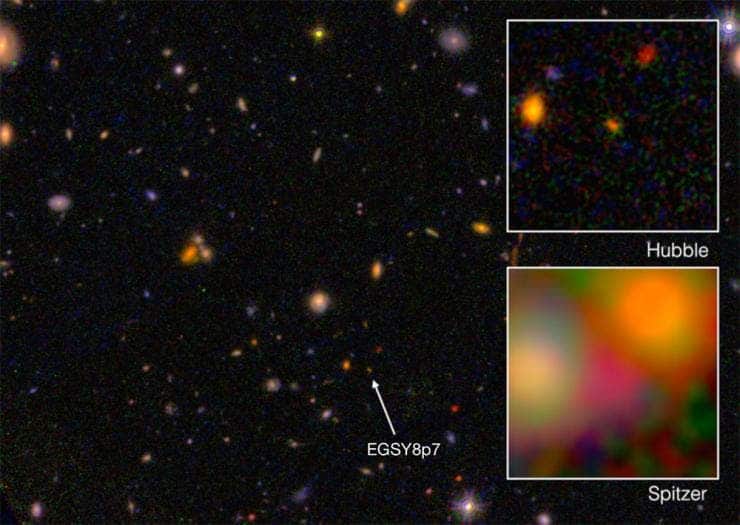NASA’s Hubble Space Telescope and the Spitzer Space Telescope jointly used their instruments to identify the oldest galaxy yet seen. Dubbed EGS8p7, this unusually luminous galaxy was formed just 600 million years after the Big Bang. When you peer that far into space and time, you’re bound to find some freaky stuff. EGS8p7 did no disappoint. Already, the 13.2 billion-year-old galaxy is raising questions about how we think the Universe evolved during its infancy.

Shortly after the Big Bang, everything was a mess – a really hot mess of charged protons and electrons. These particles chaotically dispersed throughout the early universe in such a way that photons could not travel freely, hence there was no light. This lasted for some 400,000 years post-Big Bang until the the universe cooled to the level that protons and electrons combined to form neutral hydrogen. This enabled the first light in the cosmos, that from the Big Bang, to finally shine. However, there was no other sources of light since stars hadn’t formed yet – this was the dark ages. Then, roughly 500 million years later the universe entered the age of reionization when the first galaxies lit up.
Here’s where EGS8p7 falls into all of this, though. When hydrogen gas is heated by ultraviolet rays, it produces a telltale spectral emission called Lyman-alpha line. Typically, when you see this spectral signature it’s a sign of star formation inside a newborn galaxy. Such was the case of EGS8p7, but at the same time the timeline of the galaxy is off with the current theory, particularly the age of reionization. Theoretically, we shouldn’t be able to register a Lyman-alpha line in such an ancient galaxy. Something does not compute.
“The surprising aspect about the present discovery is that we have detected this Lyman-alpha line in an apparently faint galaxy at a redshift of 8.68, corresponding to a time when the universe should be full of absorbing hydrogen clouds,” Richard Ellis of the California Institute of Technology and co-author of the paper.
“The galaxy we have observed, EGS8p7, which is unusually luminous, may be powered by a population of unusually hot stars, and it may have special properties that enabled it to create a large bubble of ionized hydrogen much earlier than is possible for more typical galaxies at these times,” added Sirio Belli, a Caltech graduate student part of the project.
Adi Zitrin, another co-author, says that the physics behind the theory of the early universe evolution isn’t essentially wrong. The discovery of EGS8p7 just adds another dimension. It means things are a bit more complex than previously thought and, most likely, reionization may not have happened in a unified matter. This particular ancient galaxy may have formed in a blind spot allowing it to shine despite its surroundings.



